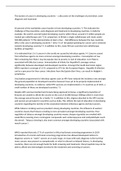Essay
The Burden of Cancer on Developing Countries Essay Cancer Biology The Biology of Cancer, ISBN: 9780815345282
Essay on the epidemiology of Cancer in terms of its effect on the world as a whole. I scored a First on this Essay from a Russel Group University.
[Show more]




